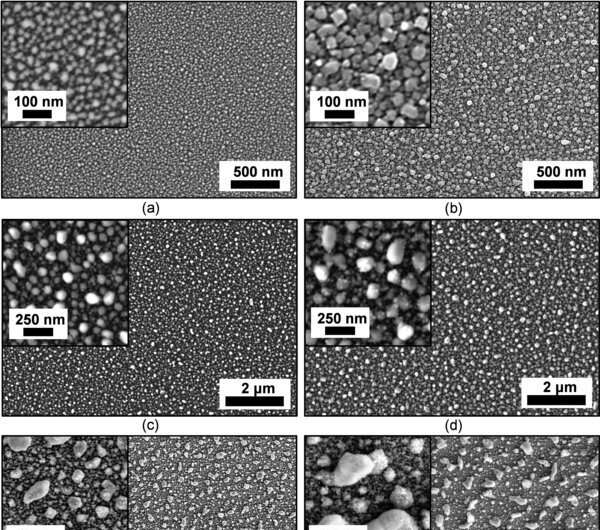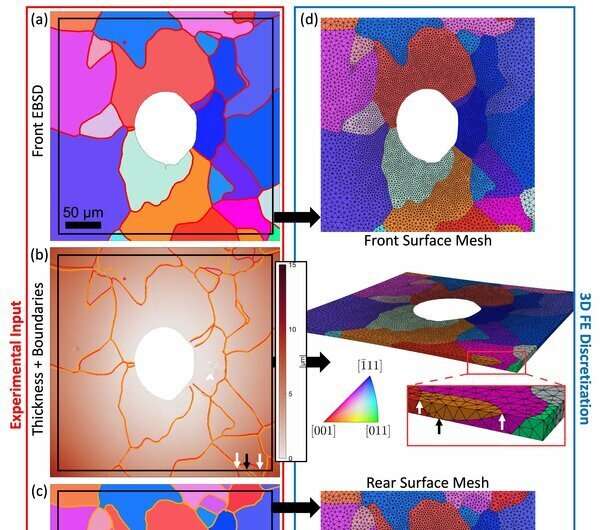This article has been reviewed according to Science X's editorial process and policies. Editors have highlighted the following attributes while ensuring the content's credibility:
fact-checked
trusted source
proofread
Researching how to make steel lighter, stronger and more durable

The automotive industry frequently uses steels containing multiple phases, in particular soft ferrite and hard martensite. These types of steel have complex microstructures, making it difficult to control the processes of plastic deformation and damage caused by pressure.
Tijmen Vermeij, who is defending his dissertation today (April 24), researched exactly how and why these processes occur in multi-phase steels. To identify these mechanisms, he developed new measurement methods. His research can aid the development of stronger steels with better properties, thereby contributing to a reduction of CO2 emissions.
Steel production is responsible for around seven percent of CO2 emissions worldwide, making it one of the most polluting industries. The development of steel with better properties means the weight of the materials used to make cars can be decreased without compromising safety. If car manufacturers need less material for production, this will directly result in the reduction of CO2 emissions caused by steel production. And there's an indirect effect too, as lighter cars use less gas.
Strong and ductile
The major challenge is to develop materials with a relatively low weight that are very strong and, at the same time, ductile. After all, the material needs to be able to withstand a crash—i.e., offer sufficient safety—but you also need to be able to deform a sheet of steel into, say, a car door. The two properties need to be optimally balanced. If the material is too strong and too brittle, it will shatter under great impact. If it's too soft, it will deform too easily.
"Take a teaspoon. You can easily deform it without breaking it, but you don't need a lot of force to do so," Ph.D. candidate Tijmen Vermeij explains. "The challenge is to develop new steels that are very strong, but that can still deform if you apply a lot of force to them. And that's pretty hard."
In the automotive industry, multi-phase steels—advanced types of steels containing multiple phases—are very popular. Examples include dual-phase steel (DP steel), which consists of a soft ferrite structure with hard martensite islands. The combination of different phases results in complex and fine microstructures with better properties. In spite of these refined properties, these steels can still break or damage unexpectedly, through deformation mechanisms we currently don't understand well enough. "We need a lot of insight in crucial deformation and damage mechanisms to develop steels with even better properties," the Ph.D. candidate says.
New methods
In the context of his Ph.D. research at the Department of Mechanical Engineering, Vermeij investigated the exact manner in which DP deforms. He also developed a series of new methods for measuring and identifying these deformation mechanisms.
On the micro level, DP steel has two phases, typically ferrite and martensite. Whereas ferrite is very soft, making it easy to deform, martensite, which forms little islands in this soft structure, is very strong. This material makes for very good properties, but when you deform it, this results in damage, in particular near the martensite islands.
"Because of the mismatch between the hard and soft microstructure, deformation results in small punctures," Vermeij explains. "If you have a lot of these punctures close together, the material might break."
"A lot of research has been done into where exactly in the microstructure the damage occurs, for example in the martensite island or on its edge, but that's where it generally stops," he goes on. "What we don't really understand is how it happens exactly. Ideally you want to measure right away how the deformation occurred."
Microscans
Vermeij developed a new measurement method, based on Digital Image Correlation (DIC), to study the deformations at the micrometer level. This involves depositing a pattern on the microstructure and using an electron microscope to make scans before and after the deformation. These scans can then be compared for differences, using special software.

"This allows you to see that part of the pattern has gone, which means it's broken. But plastic deformation can also happen, meaning that the material has been significantly and permanently deformed, but doesn't break," Vermeij explains. "Like a bent teaspoon."
You can measure this and attribute a value to every position. Some positions have high values, in case of significant deformation, and others have low ones, in case the material has hardly deformed at all.
Experiments and simulations
An important part of the dissertation is taken up by two papers that resulted from close collaboration with fellow Ph.D. candidate Job Wijnen. While Vermeij was busy experimenting, identifying and measuring, his colleague performed research based on simulations. In the end they combined both methods by integrating the simulations with the experiments and comparing the results.
Vermeij states, "Running experiments is a lot of work. But the computer can perform thousands of simulations, so you can do a lot more." The automotive industry makes a lot of use of simulations, for example when a new part needs to be made, so you don't have to do it in real life. At the moment simulations are only useful to get an idea of whether simple deformations will work or not, as they're not entirely reliable. "If you push your luck with a deformation, the material may rupture, even though you wouldn't expect this based on the simulation."
One reason for this is that simulations are partly based on assumptions, due to a lack of precise or complete data. "If you have a piece of DP steel, you can measure the microstructure at the surface, but you can't see what's happening underneath," Vermeij explains. "The piece of metal you end up testing in an experiment has a thickness of one millimeter. If you run a simulation, you can only input the information you have, so just your knowledge of the surface. But a few micrometers deeper it'll be completely different and that's the information you're missing. That poses a big challenge and makes it very complex."
According to Vermeij, the collaboration was crucial to his Ph.D. research. "This method of running simulations based on experiments that match each other as closely as possible is of key importance and very useful to improve simulations at high levels of industry."
Research has previously been done based on simulations and experiments, but this always involved cutting off a small sample that can only be used to visualize very simple deformations. By using a very thin sample combined with a very large area—spanning 300 micrometers and with a maximum thickness of 10 micrometers—you can also study complex deformations. "One might say we found the golden mean between very simple experiments, which don't teach you a whole lot, and very complex experiments that don't allow for good simulations," Vermeij concludes.
This integration of simulations and experiments is a great example of close collaboration between Ph.D. candidates working on the same research question and mutually reinforcing one another. "And the most important thing is of course that the method shows it works well, that there's a good match between simulations and experiments," Vermeij emphasizes.
Stronger steel with less damage
In one of the experiments, Vermeij investigated how damage occurs in the hard martensite islands in DP steel made up of martensite and ferrite. "Martensite is very strong and brittle, so you would expect there to be damage if it deforms. But one theory claims that there's a way for the hard phase to deform very softly. Just the one way, and a very specific one at that. As a result, some positions are very difficult to deform but in other positions plastic deformation can occur, so with a permanent effect and without any damage occurring."
Vermeij researched this using experiments and found out that there was one case of very significant deformation without damage occurring. With a unique identification method designed for his Ph.D. research, he demonstrated that this significant deformation always occurs on a single face. This is of great importance for the future development of steels. Using this knowledge, you can develop materials in such a way that less damage occurs, which in turn enables you to use less material.
Beyond trial and error
Steel has an infinite number of compositions, heat treatments and combinations thereof, so there are infinite ways of making steel. Adding a bit of silicon, manganese or aluminum results in steel with new properties.
"Until now this mostly happened on a trial and error basis or with a limited understanding in terms of 'if you do this, approximately that will happen.' But in the end it takes a lot of experiments and simulations to better control plasticity and damage and to develop steels with better properties," says Vermeij. His research and new, more precise measurement methods are an important step in this direction.
More information: High-Resolution Identification of Plasticity and Damage in Multi-Phase Steels, pure.tue.nl/ws/portalfiles/por … 30421_Vermeij_hf.pdf

















